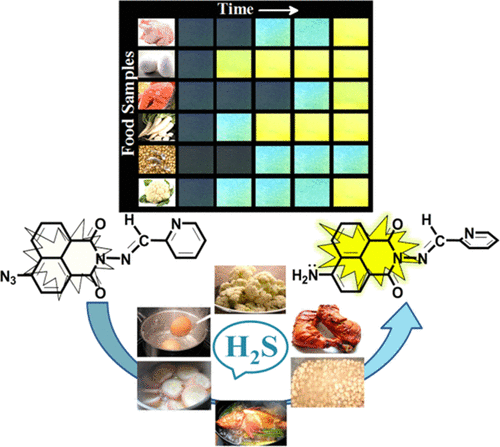Our official English website, www.x-mol.net, welcomes your
feedback! (Note: you will need to create a separate account there.)
Consumption of H2S from Our Daily Diet: Determination by a Simple Chemosensing Method
ACS Omega ( IF 3.7 ) Pub Date : 2018-09-21 00:00:00 , DOI: 10.1021/acsomega.8b01751 Ayndrila Ghosh 1 , Sujoy Das 1 , Himadri S. Sarkar 1 , Shampa Kundu 1 , Prithidipa Sahoo 1
ACS Omega ( IF 3.7 ) Pub Date : 2018-09-21 00:00:00 , DOI: 10.1021/acsomega.8b01751 Ayndrila Ghosh 1 , Sujoy Das 1 , Himadri S. Sarkar 1 , Shampa Kundu 1 , Prithidipa Sahoo 1
Affiliation

|
A unique method has been developed for comparative analysis of H2S produced from food samples from our daily diet, both qualitatively and quantitatively. The selective detection of H2S has been executed by introducing a simple chemodosimeter (PN-N3) that gives response on the basis of intramolecular charge transfer. UV–vis, fluorimetric, and NMR titrations were performed to demonstrate the sensing mechanism and electronic environment of PN-N3 in the presence of H2S. Density functional theory calculations were performed to validate the mechanism of azide (PN-N3) reduction to amine (PN-NH2) by the strong reducing power of H2S. The potentiality of this chemosensing method is that it could be treated as a simple, less-time-consuming, and cost-effective method for determining H2S in biological samples in the nanomolar range.
中文翻译:

我们日常饮食中H 2 S的消耗:通过简单的化学传感方法测定
一个独特的方法已经开发了比较分析h的2期从食物样品制备从我们的日常饮食,定性和定量。H 2 S的选择性检测已通过引入简单的化学计量计(PN-N 3)来进行,该化学计量计基于分子内电荷转移给出响应。进行了UV-vis,荧光和NMR滴定,以证明在H 2 S存在下PN-N 3的传感机理和电子环境。进行了密度泛函理论计算,以验证叠氮化物(PN-N 3)的机理。还原成胺(PN-NH 2)通过H的还原力强2 S.这种化学传感方法的潜力是,它可以作为一种简单,费时较少,且成本有效的方法来处理用于确定ħ 2的生物样品中在纳摩尔范围内。
更新日期:2018-09-21
中文翻译:

我们日常饮食中H 2 S的消耗:通过简单的化学传感方法测定
一个独特的方法已经开发了比较分析h的2期从食物样品制备从我们的日常饮食,定性和定量。H 2 S的选择性检测已通过引入简单的化学计量计(PN-N 3)来进行,该化学计量计基于分子内电荷转移给出响应。进行了UV-vis,荧光和NMR滴定,以证明在H 2 S存在下PN-N 3的传感机理和电子环境。进行了密度泛函理论计算,以验证叠氮化物(PN-N 3)的机理。还原成胺(PN-NH 2)通过H的还原力强2 S.这种化学传感方法的潜力是,它可以作为一种简单,费时较少,且成本有效的方法来处理用于确定ħ 2的生物样品中在纳摩尔范围内。









































 京公网安备 11010802027423号
京公网安备 11010802027423号